2. Cash
For most people, when they think of money, it is cash – banknotes and coins – that springs to mind. Banknotes are monetary notes made of special paper. Coins are stamped pieces of metal. They both come in specific denominations of a given currency, with different face values. Since the beginning of 2002, Germany’s currency has been the euro, which it shares with the rest of the euro area. Banknotes are supplemented by coinage for making small payments. As a general rule, the face (or nominal) value of a coin is higher than the value of the metal from which it is made, and you might hear the terms fiat coins or token coinage used to describe this. The euro coins are an example of this principle.
Euro cash is legal tender in the euro area.
Euro banknotes are the sole unrestricted legal tender in the euro area. Unless both parties have made a contractual agreement to the contrary, and provided that there are no legal barriers to acceptance, creditors are obliged to accept from their debtors any settlement of a money claim offered in the form of banknotes. No limit applies to the volume of banknotes that may be used for the payment.
Unlike banknotes, euro coins are legal tender only to a limited extent. In the euro area, creditors are under no obligation to accept more than 50 euro coins per payment. Creditors and debtors are also within their rights to contractually rule out the option of paying with coins at all.
2.1 Cash issuance
Anyone who uses cash has to be able to rely on banknotes and coins being valid as currency. That is why cash is issued only by government institutions, and not by private companies. They guarantee the high quality and security of banknotes and coins.
Monopoly on banknote issuance and the coinage prerogative
Banknotes are issued by the central bank, coins by the state.
In the euro area, the European Central Bank (ECB) and the national central banks of the countries that have introduced the euro as their common currency are authorised to issue banknotes. In Germany, the Deutsche Bundesbank has the monopoly on issuing banknotes. It puts banknotes into circulation chiefly via commercial banks. The volume of banknotes brought into circulation is determined purely on the basis of demand. The Bundesbank therefore issues all the cash that banks and their customers need – usually on the basis of loans to commercial banks.
Unlike banknotes, euro coins are the responsibility of the euro area countries. This is a relic of an age when coins were the only form of currency. Even back then, the authority to regulate coin issuance lay with the respective ruler or the state. This is known as the coinage prerogative. In Germany, it is the Federal Ministry of Finance which commissions euro coin production. The Bundesbank then brings the coins into circulation.
No backing requirements
The issuance of euro cash is not tied to any backing requirements.
In the past, note-issuing banks were bound by an obligation to exchange banknotes for gold or silver, meaning they often had to hold a sufficient quantity of the relevant precious metal to cover (or “back”) a certain percentage of the paper money in circulation. Banknote issuance was therefore limited by the precious metal reserves on hand. We now know, however, that there is no need for arrangements of this kind to safeguard the value of money.
Euro area central banks are therefore under no obligation to convert the value of any banknote with which they are presented into its equivalent value in gold or other assets. They can always service all euro liabilities – in other words, they cannot become insolvent (or “illiquid”) in euro. National central banks in the euro area, such as the Bundesbank, also accept euro coins at face value and exchange them for banknotes or convert them into a credit balance on an account. As with banknotes, they cannot be exchanged for other assets.
2.2 The cash cycle in Germany
Specialised printing works and mints manufacture the banknotes and coins and deliver them to the Bundesbank. They are collected from the Bundesbank’s branches by commercial banks or their appointed cash-in-transit (CIT) companies – private enterprises that transport valuables such as cash. The money then enters the economic cycle, being supplied by the banks to businesses and consumers. As a counterflow, participants in the economic cycle deposit any excess cash at the commercial banks.
Using machines tested by euro area central banks, banks and CIT companies can check banknotes for quality and authenticity and then put them straight back into circulation. Any cash that does not make the grade or is surplus to requirements is returned to the Bundesbank.

Cash use in Germany
Although cash is steadily losing ground against cashless forms of payment, a Bundesbank survey on “Payment behaviour in Germany in 2021” found that 58% of payment transactions made by individuals for the purchase of goods and services were still settled in cash. When measured in terms of value, this equates to 30% of payments at the point of sale. Individuals carried around €100 in their wallets on average. Neither digitalisation nor the pandemic have been able to oust cash. 69% of the respondents said they intend to continue paying in cash in the future as hitherto.

Cash’s advantages include that it can be used quickly and anonymously, without the need for any special technical tools or other aids. It can also be redeposited into an account at any time.
Maintaining the quality of cash
The Bundesbank replaces damaged and soiled euro cash with banknotes and coins that are fit for circulation.
Banknotes and coins that make their way back to the Bundesbank’s branches are checked for authenticity and fitness for circulation. Damaged and soiled banknotes are removed from circulation, shredded, compressed into briquettes and disposed of. Counterfeit money is also identified and removed from circulation at the branches. To help track down counterfeiters, Bundesbank experts analyse any counterfeits that are found and store them so that they can be used as evidence in the event of a court hearing.
The Bundesbank’s branches process around 15 billion euro banknotes every year. To do this, they use high-performance machines, which are able to check 28 banknotes per second for authenticity and fitness for circulation.
Coins that are no longer fit for circulation are also withdrawn from the cash cycle by the Bundesbank. They are invalidated on behalf of the Federal Ministry of Finance and then sold to metal production facilities. The metal used to make the coins is thus recycled. Euro banknotes and coins that have been removed from circulation are replaced by the Bundesbank’s branches with cash that is fit for use.

The lifespan of a banknote depends primarily on its face value. Small denomination banknotes (€5, €10, €20 and €50) are replaced after one to four years. Large denominations (€100, €200, €500) may survive much longer than ten years in circulation. Coins, meanwhile, wear out very slowly; they can often be used for decades.

Replacing damaged cash

Time and again cash winds up getting accidentally damaged in the course of daily life – it gets torn, put in the washing machine with the laundry, inadvertently shredded or even nibbled at by pets, for instance.
If a euro banknote is so severely damaged that it can no longer be accepted as payment, the euro area national central banks – including the Bundesbank – will offer a replacement, provided that the banknote fragments submitted by the bearer make up more than half of the banknote. Otherwise the bearer must prove that the rest of the banknote has been destroyed. Banknotes that have been stuck together with the intention to defraud will not be replaced.
The Bundesbank replaces damaged euro coins if the coins are worn or soiled as a result of normal usage in payments.
2.3 The euro banknotes
Euro banknotes come in seven denominations: €5, €10, €20, €50, €100, €200 and €500. Their different colours and sizes make them easy to tell apart. The larger the denomination, the larger the banknote.
The first series of euro banknotes is being replaced by the Europa series.
The banknotes depict architectural styles from seven periods of European cultural history – in the form of windows, gates and bridges. These are modelled on the style of the respective era and do not exist in real life. The windows and gateways on the front – or obverse – side of each banknote are intended to symbolise the spirit of openness and cooperation in Europe. The bridges on the reverse side of the banknotes represent the ties between the peoples of Europe and between Europe and the rest of the world.
The first series of banknotes has been in circulation since the start of 2002. It was replaced by a new series between 2013 and 2019. The euro banknotes are the product of a design competition held in the mid-1990s, which was won by Robert Kalina from Austria. Reinhold Gerstetter, a former designer of the Bundesdruckerei in Germany, adapted the design of the second series.
The first series of euro banknotes
Colour, architectural style, size



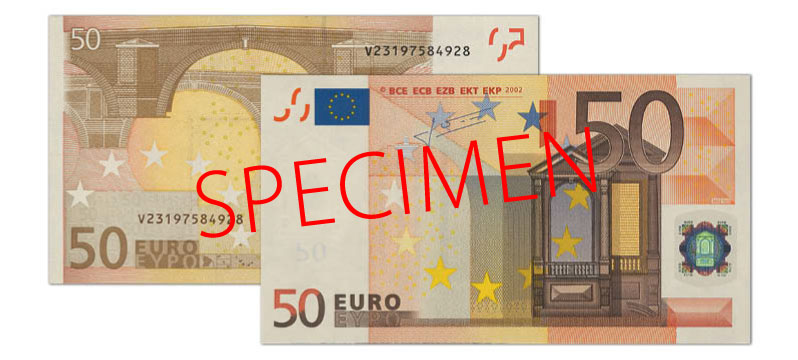



The second series of euro banknotes

- Colour: Grey
- Architectural style: Classical
- Size: 120 × 62 mm
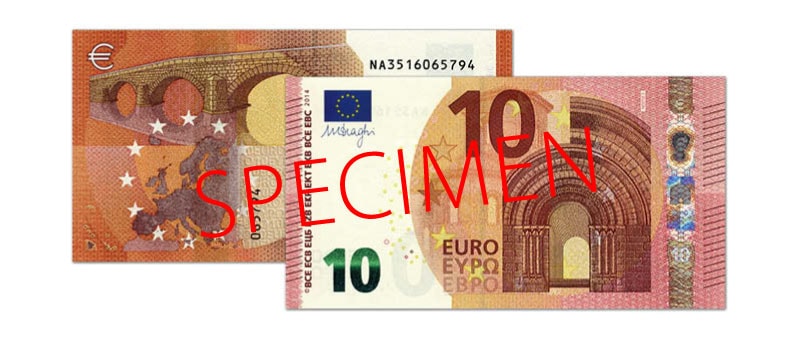
- Colour: Red
- Architectural style: Romanesque
- Size: 127 × 67 mm

- Colour: Blue
- Architectural style: Gothic
- Size: 133 × 72 mm

- Colour: Orange
- Architectural style: Renaissance
- Size: 140 × 77 mm

- Colour: Green
- Architectural style: Baroque and rococo
- Size: 147 × 77 mm

- Colour: Yellow-brown
- Architectural style: 19th century iron and glass architecture
- Size: 153 × 77 mm
The second series of euro banknotes (Europa series)
No fundamental changes to the design were made for the second series of euro banknotes. However, the new banknotes have more vibrant colouring with higher contrast. The security features have been improved and new elements have been added. The notes now include a portrait of Europa, a figure from Greek mythology, which appears in the watermark and hologram.
The general features of the banknotes, such as the signature of the ECB President, the flag of the European Union and the abbreviations for the European Central Bank in various European languages, have been retained.
The Europa series does not include €500 banknotes. €500 banknotes issued as part of the first series remain valid. The same applies to all other first series banknotes still in circulation.
The development of future euro bank-notes has already started. Experts are drawing up proposals for themes on which the public’s input will be solicited, after which a design competition will be held. The final decision on the new de-sign is scheduled to be taken in 2024.
The general features of the second series of euro banknotes

Production
The euro area national central banks share responsibility for printing euro banknotes. The banknotes are manufactured by state printing works or private specialist printers. To keep costs down, not every central bank produces every denomination. Instead, the national central banks are only responsible for printing selected banknotes, which are determined on an annual basis.
Like the first series, the Europa series banknotes have a serial number on the reverse side. The long-form runs horizontally and consists of two letters and ten digits. The first letter identifies the printing works.
Provenance of the Europa series banknotes

2.4 The euro coins
The individual euro area countries are responsible for issuing euro coins, though the overall issuance volume has to be approved by the Governing Council of the ECB. Euro coins come in eight denominations: 1, 2, 5, 10, 20 and 50 cent as well as €1 and €2. These coins issued for day-to-day transaction purposes are referred to as circulation coins.
Unlike euro banknotes, euro coins have only one side that is common to all euro area countries. The other side features country-specific designs. In addition to the 19 euro area Member States, Monaco, San Marino, Vatican City and Andorra have an agreement with the European Union allowing them to issue euro coins with their own national sides.
The European side

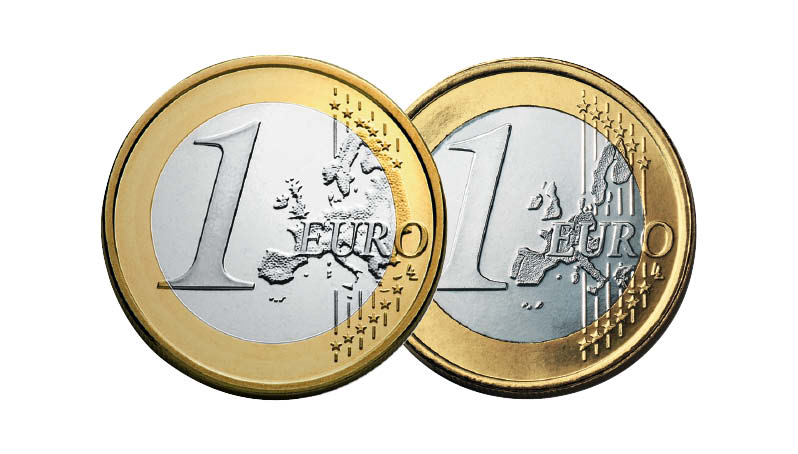
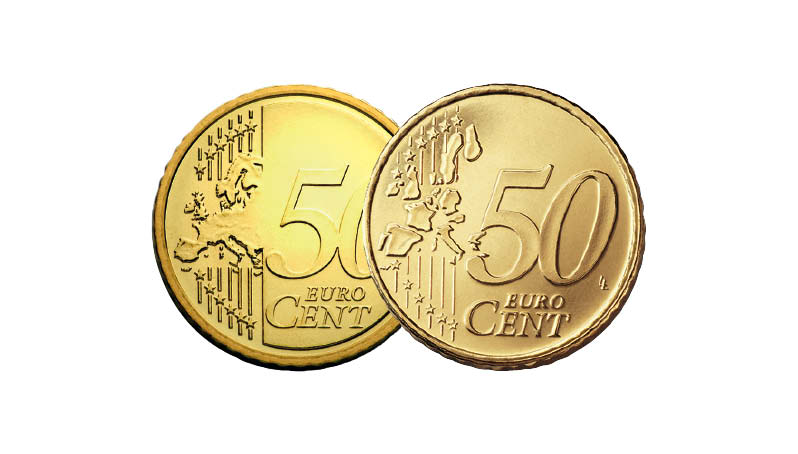


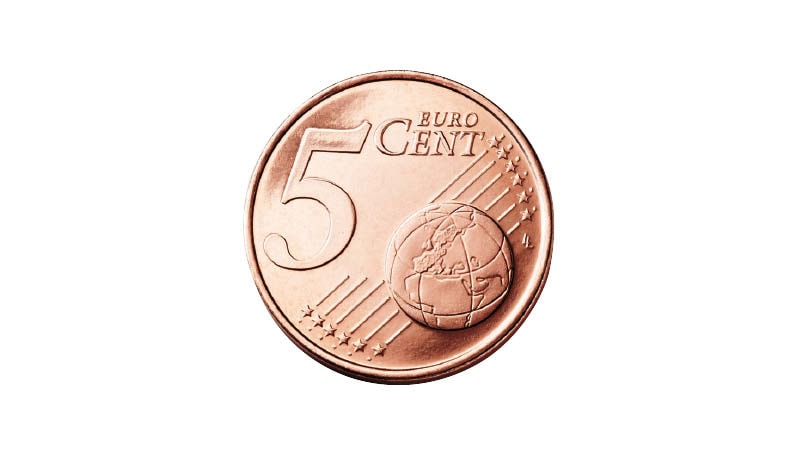


Old: Version with 15 EU Member States. New: Updated European side (from 2007 onwards).
Design of 1, 2 and 5 cent coins unchanged.
The European side
The common European side of the coins symbolises the unity of the European Union (EU). It shows the coin’s value alongside differently stylised maps of Europe or, depending on the denomination, a globe symbolising “Europe in the world” plus twelve stars (echoing the motif from the EU flag). The design of the European side on five of the coins (€1 and €2 as well as 10, 20 and 50 cent) was reworked in 2007 to reflect the enlargement of the European Union. Instead of depicting the 15 countries that had made up the EU prior to enlargement, the new coins minted from 2007 onwards show a map of Europe without national borders.
The common side of the coins was chosen in 1997 from entries submitted to a design competition organised by the European Commission. The winner, Luc Luycx from Belgium, is credited on the coins with the inclusion of his initials “LL”.

The national side
Each country selects its own design for its national side. Although the national designs are all different, the circulation coins of all euro area countries are valid legal tender throughout the entire euro area.
Germany’s euro coins


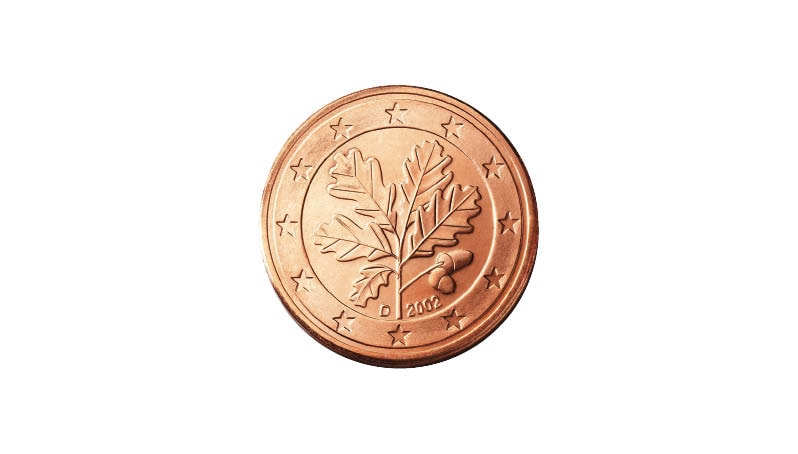
The national sides of the euro area countries’ €1 coins





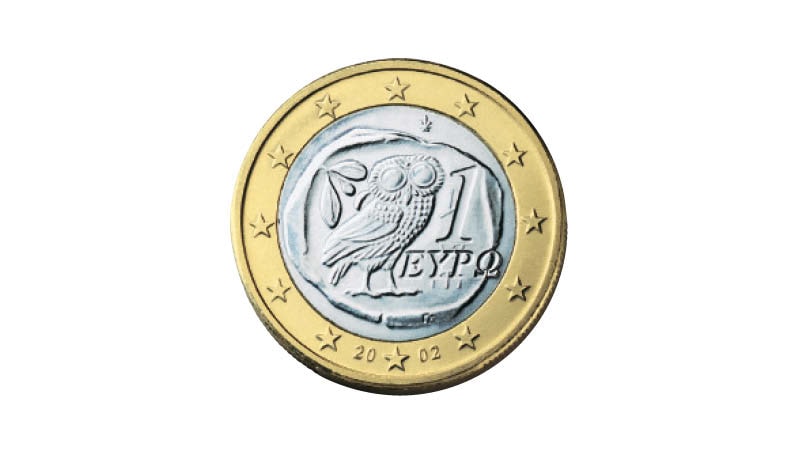














Euro area countries are allowed to change their national coin designs when a head of state depicted on their coins changes; this has happened with Belgium, the Netherlands and Spain.
Production
The metals used to make the coins were chosen on the basis of practicality and cost. In particular, the alloys must not be prone to rusting and need to be able to withstand the wear and tear of use. It is also important that skin contact should not trigger an allergic reaction. Another key factor is that the metal value must remain below the coin’s face value. Otherwise, there would be a risk of the coins being melted down and traded as commodities.
Germany has five federal mints that still produce coins. The letter stamped on the coin shows which mint produced it. The letters seem arbitrarily assigned but were actually inherited from the imperial government which, immediately after the establishment of the German Empire in 1871, sequenced all of the mints existing at that time alphabetically.
Germany’s mints and their mintmarks

The edges of the euro coins

The eight euro coins differ from one another in size, weight, material, colour and thickness. The €1 and €2 coins consist of an inner core and an outer ring, each made of different metal alloys. This is what gives these coins their bi-colour appearance. Certain features were introduced to make it easier for the blind and visually impaired, in particular, to distinguish between the various denominations. For instance, each denomination has a different style of edge.
Commemorative and collector coins
Euro area countries are also permitted to issue commemorative and collector coins with specially designed national coin sides to mark special occasions. The €2 commemorative coins count as legal tender in all euro area countries – just like the €2 circulation coins. In Germany, for example, a special €2 coin celebrating a different federal state each year has been issued since 2006.
Examples of Germany’s €2 commemorative coins
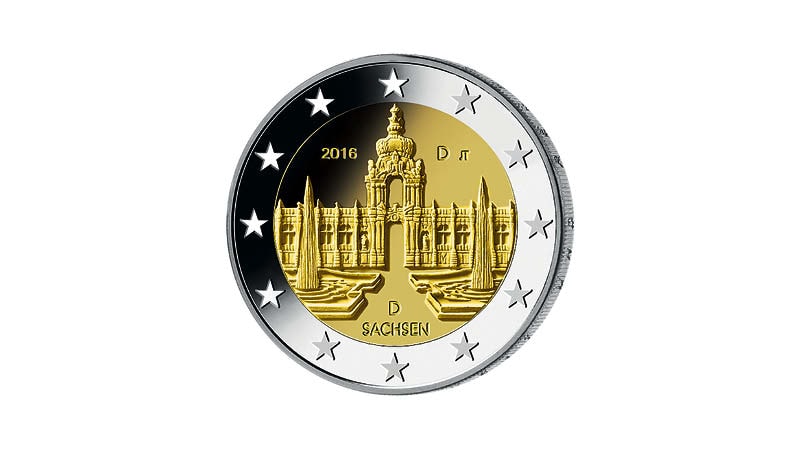




Joint €2 commemorative coins (German issues)
Other countries also issue their own €2 commemorative coins with national designs. In 2013, France and Germany issued a joint €2 coin as a sign of their friendship. In addition, anniversaries of key European events are marked by jointly issued €2 commemorative coins in the euro area countries.




There are also euro collector coins with higher face values that are only valid as legal tender in their country of issue. Under the German Coinage Act (Münzgesetz), no party is obliged to accept German collector coins in the amount of more than €200 for any single payment.
Euro collector coins are legal tender only in their country of issue.
Since euro cash was introduced in 2002, the Federal Government has issued multiple German euro collector coins each year. They have various face values (ranging from €5 to €200) and are made of different materials. Gold coins are available from a face value of €20. 2016 saw the launch of an innovative collector series consisting of coins with coloured and translucent polymer rings. German-issued euro collector coins are legal tender only in Germany.
German euro collector coins can be purchased from Münze Deutschland (formerly the Official Sales Agency for Collector’s Coins of the Federal Republic of Germany (VfS)). They are priced higher than their face value due to their particularly high quality and special packaging. €5, €10 and €20 collector coins (excluding gold coins) can be purchased from the Bundesbank’s branches at face value.
Examples of German collector coins issued in 2021
Face value, material, design/series






2.5 Using security features to spot counterfeit money
In order to safeguard the public’s confidence in the cash in circulation, banknotes and coins incorporate a range of security features to make them harder to counterfeit. Furthermore, it is a criminal offence to produce counterfeit money or place it into circulation. And anybody who knowingly passes on counterfeit banknotes or coins that they have ended up with is also committing a crime. Counterfeit money will never be reimbursed, so all parties have to make sure that they only accept genuine banknotes and coins when money is changing hands.
The national central banks of the euro area – including the Bundesbank – keep a close eye on new developments in printing and reproduction technologies. They regularly adapt the security features of euro banknotes to advances in technology. Central banks analyse counterfeits that turn up in their country, store them and enter the results of their examinations into a Europe-wide database. They collaborate closely with national and international police authorities on measures to prevent and combat counterfeiting.
Security features of euro banknotes
Security features allow euro banknotes to be checked for authenticity.
The security features enable any vigilant cash user to identify counterfeits even without the use of special equipment. The banknotes in the Europa series include security features that are at the cutting edge of banknote technology. A key hallmark of the Europa series is the portrait of the mythological figure of Europa, which – together with the value numeral – appears in the new watermark when the note is held up to the light and in the new hologram.

The larger the denomination, the more security features the banknotes include. Denominations of €20 and above have additional security features that can be used to check for authenticity beyond those common to all euro banknotes.

Security features of euro coins
Coins are also furnished with security features. On a genuine coin, you can feel that the relief of the design is clearly raised and distinct from the rest of the coin’s surface. All of its contours are clear-cut, sharply defined and can be easily discerned. The same is true of the coin’s edge.
The €2 coin has lettering stamped on the edge, making it even harder to counterfeit. The bi-colour nature of the €1 and €2 coins also helps to prevent forgery.

Checking authenticity using the “feel, look, tilt” method
With a little attention to detail, anybody can use the security features to help prevent themselves from accepting counterfeit banknotes. The “feel, look, tilt” method is a way of quickly verifying whether a banknote is genuine or not.


The incidence of counterfeit money
At roughly five counterfeits per 10,000 inhabitants in 2021 – around 42,000 forged banknotes – the incidence of counterfeit money in Germany is extremely low. The €20 denomination was the most frequently counterfeited banknote. Counterfeit coins are rare, too. Some 41,100 counterfeit coins were de-tected in 2021, of which roughly 93% were €2 coins.

What to do with counterfeit money
If you suspect money is counterfeit, there are a few things to remember. When checking a suspected counterfeit, it can help to compare it with a banknote that is known to be genuine. However, suspicious banknotes should be touched as little as possible to avoid smudging any fingerprints.
Money clearly identified as counterfeit should be handed over to the police immediately, along with details as to where it came from. If known, information about the person who handed out the counterfeit money is also helpful. Responsible conduct like this supports the police in their investigations.
DOWNLOAD MATERIAL
FEEDBACK
Key points:
- Cash refers to coins and banknotes. Euro banknotes and coins are legal tender in the euro area.
- Banknotes are issued by the central bank (monopoly on banknote issuance) and coins by the state (coinage prerogative).
- The euro is not backed by gold or other precious metals. The Eurosystem is not obliged to exchange euro-cash for gold or other assets.
- The Bundesbank brings cash into circulation in Germany. It replaces worn and damaged banknotes and coins and withdraws counterfeits from circulation.
- Euro banknotes are the same throughout the euro area. They have security features that allow everyone to check banknotes for authenticity.
- In 2013, the Eurosystem began issuing the second series of euro banknotes (Europa series) with enhanced security features. Both series are unrestricted legal tender in the euro area.
- There are eight euro coins; they each have a common European side and a national side featuring a design created by the individual euro area Member States.
- All €2 commemorative coins are also legal tender throughout the euro area.
- Counterfeit money must be handed over to the police immediately. Anybody who produces counterfeit money or knowingly brings it into circulation is liable to prosecution.
Chapter overview
Overview publications
Important links
- © Deutsche Bundesbank
- Privacy policy
- Imprint
- Declaration on Accessibility